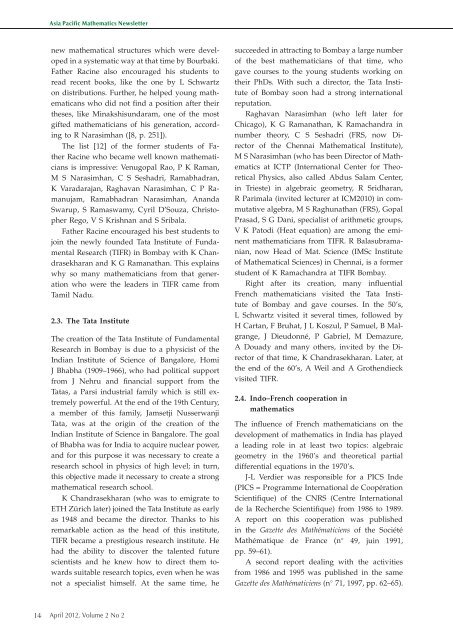Mathematics Newsletter
Mathematics Newsletter
Mathematics Newsletter
You also want an ePaper? Increase the reach of your titles
YUMPU automatically turns print PDFs into web optimized ePapers that Google loves.
14<br />
Asia Pacific <strong>Mathematics</strong> <strong>Newsletter</strong><br />
new mathematical structures which were developed<br />
in a systematic way at that time by Bourbaki.<br />
Father Racine also encouraged his students to<br />
read recent books, like the one by L Schwartz<br />
on distributions. Further, he helped young mathematicans<br />
who did not find a position after their<br />
theses, like Minakshisundaram, one of the most<br />
gifted mathematicians of his generation, according<br />
to R Narasimhan ([8, p. 251]).<br />
The list [12] of the former students of Father<br />
Racine who became well known mathematicians<br />
is impressive: Venugopal Rao, P K Raman,<br />
M S Narasimhan, C S Seshadri, Ramabhadran,<br />
K Varadarajan, Raghavan Narasimhan, C P Ramanujam,<br />
Ramabhadran Narasimhan, Ananda<br />
Swarup, S Ramaswamy, Cyril D’Souza, Christopher<br />
Rego, V S Krishnan and S Sribala.<br />
Father Racine encouraged his best students to<br />
join the newly founded Tata Institute of Fundamental<br />
Research (TIFR) in Bombay with K Chandrasekharan<br />
and K G Ramanathan. This explains<br />
why so many mathematicians from that generation<br />
who were the leaders in TIFR came from<br />
Tamil Nadu.<br />
2.3. The Tata Institute<br />
The creation of the Tata Institute of Fundamental<br />
Research in Bombay is due to a physicist of the<br />
Indian Institute of Science of Bangalore, Homi<br />
J Bhabha (1909–1966), who had political support<br />
from J Nehru and financial support from the<br />
Tatas, a Parsi industrial family which is still extremely<br />
powerful. At the end of the 19th Century,<br />
a member of this family, Jamsetji Nusserwanji<br />
Tata, was at the origin of the creation of the<br />
Indian Institute of Science in Bangalore. The goal<br />
of Bhabha was for India to acquire nuclear power,<br />
and for this purpose it was necessary to create a<br />
research school in physics of high level; in turn,<br />
this objective made it necessary to create a strong<br />
mathematical research school.<br />
K Chandrasekharan (who was to emigrate to<br />
ETH Zürich later) joined the Tata Institute as early<br />
as 1948 and became the director. Thanks to his<br />
remarkable action as the head of this institute,<br />
TIFR became a prestigious research institute. He<br />
had the ability to discover the talented future<br />
scientists and he knew how to direct them towards<br />
suitable research topics, even when he was<br />
not a specialist himself. At the same time, he<br />
April 2012, Volume 2 No 2<br />
succeeded in attracting to Bombay a large number<br />
of the best mathematicians of that time, who<br />
gave courses to the young students working on<br />
their PhDs. With such a director, the Tata Institute<br />
of Bombay soon had a strong international<br />
reputation.<br />
Raghavan Narasimhan (who left later for<br />
Chicago), K G Ramanathan, K Ramachandra in<br />
number theory, C S Seshadri (FRS, now Director<br />
of the Chennai Mathematical Institute),<br />
M S Narasimhan (who has been Director of <strong>Mathematics</strong><br />
at ICTP (International Center for Theoretical<br />
Physics, also called Abdus Salam Center,<br />
in Trieste) in algebraic geometry, R Sridharan,<br />
R Parimala (invited lecturer at ICM2010) in commutative<br />
algebra, M S Raghunathan (FRS), Gopal<br />
Prasad, S G Dani, specialist of arithmetic groups,<br />
V K Patodi (Heat equation) are among the eminent<br />
mathematicians from TIFR. R Balasubramanian,<br />
now Head of Mat. Science (IMSc Institute<br />
of Mathematical Sciences) in Chennai, is a former<br />
student of K Ramachandra at TIFR Bombay.<br />
Right after its creation, many influential<br />
French mathematicians visited the Tata Institute<br />
of Bombay and gave courses. In the 50’s,<br />
L Schwartz visited it several times, followed by<br />
H Cartan, F Bruhat, J L Koszul, P Samuel, B Malgrange,<br />
J Dieudonné, P Gabriel, M Demazure,<br />
A Douady and many others, invited by the Director<br />
of that time, K Chandrasekharan. Later, at<br />
the end of the 60’s, A Weil and A Grothendieck<br />
visited TIFR.<br />
2.4. Indo–French cooperation in<br />
mathematics<br />
The influence of French mathematicians on the<br />
development of mathematics in India has played<br />
a leading role in at least two topics: algebraic<br />
geometry in the 1960’s and theoretical partial<br />
differential equations in the 1970’s.<br />
J-L Verdier was responsible for a PICS Inde<br />
(PICS = Programme International de Coopération<br />
Scientifique) of the CNRS (Centre International<br />
de la Recherche Scientifique) from 1986 to 1989.<br />
A report on this cooperation was published<br />
in the Gazette des Mathématiciens of the Société<br />
Mathématique de France (n ◦ 49, juin 1991,<br />
pp. 59–61).<br />
A second report dealing with the activities<br />
from 1986 and 1995 was published in the same<br />
Gazette des Mathématiciens (n ◦ 71, 1997, pp. 62–65).<br />
4


